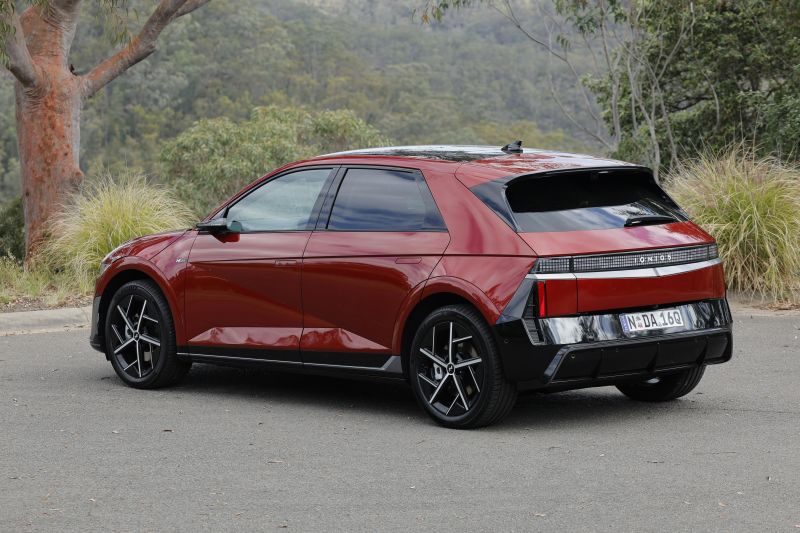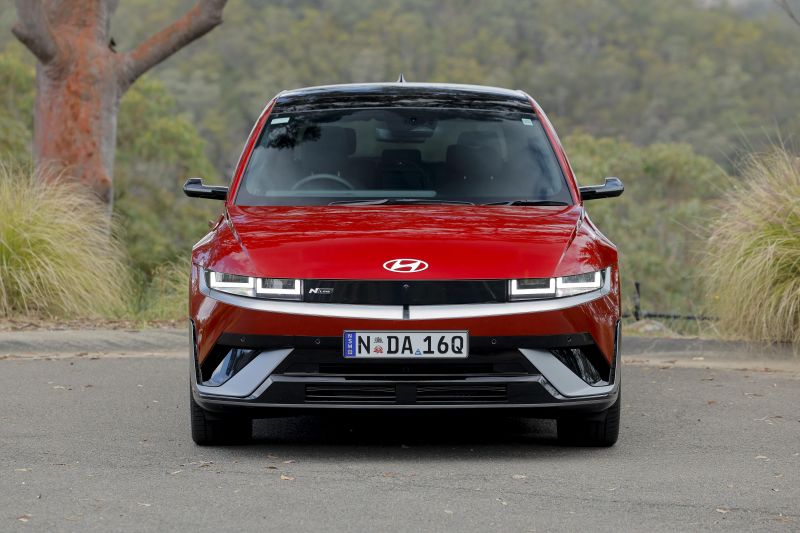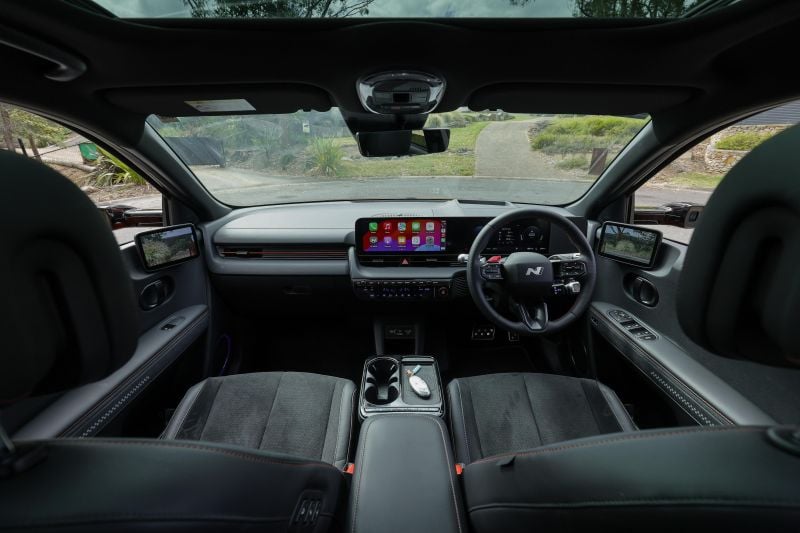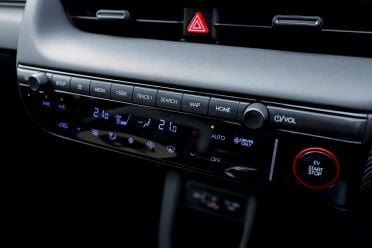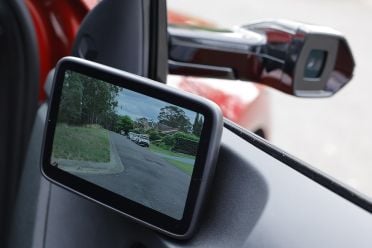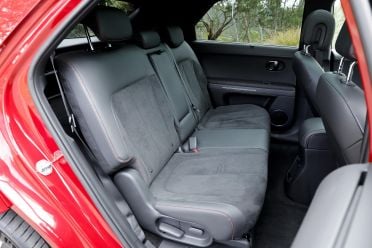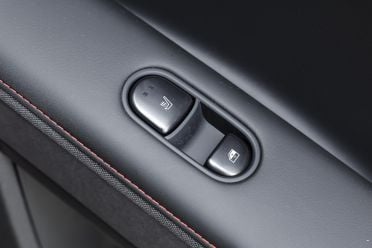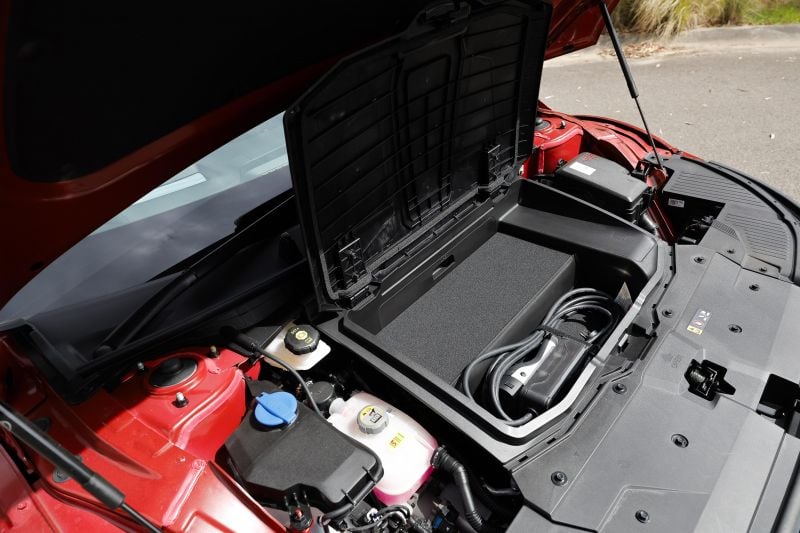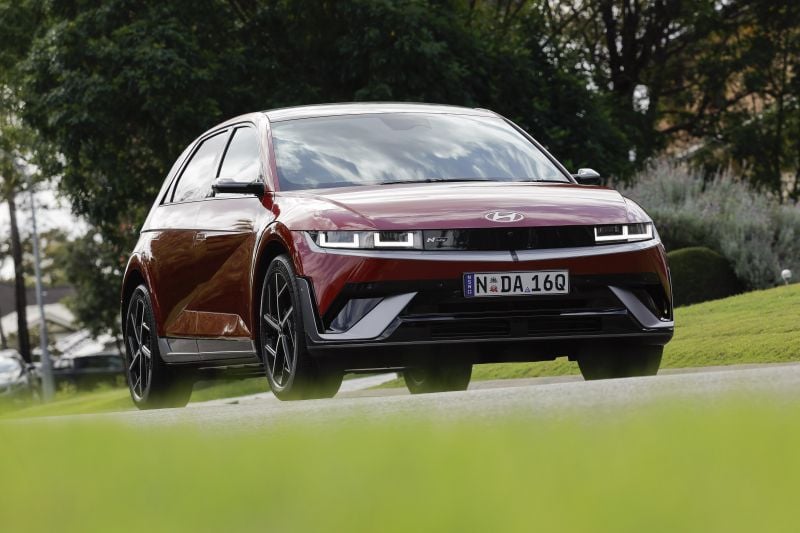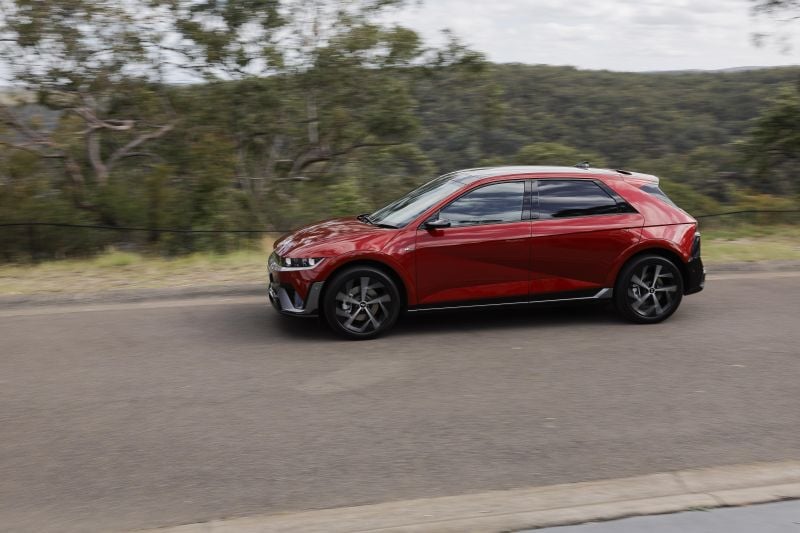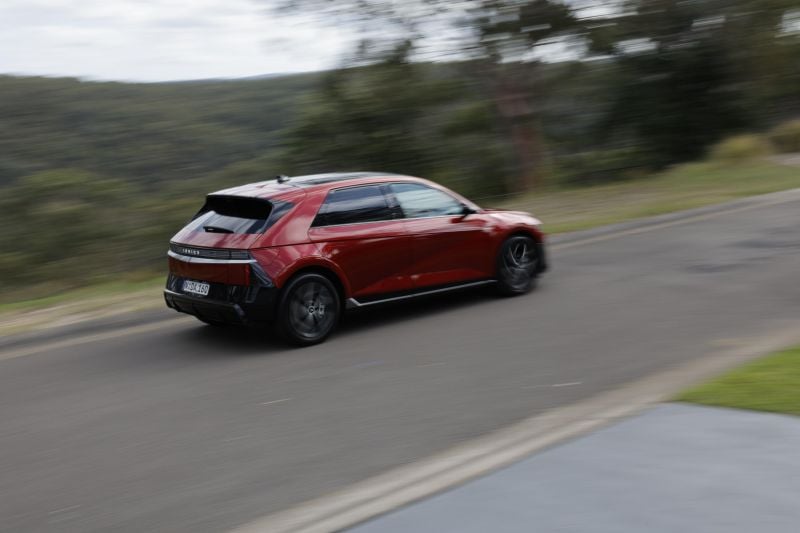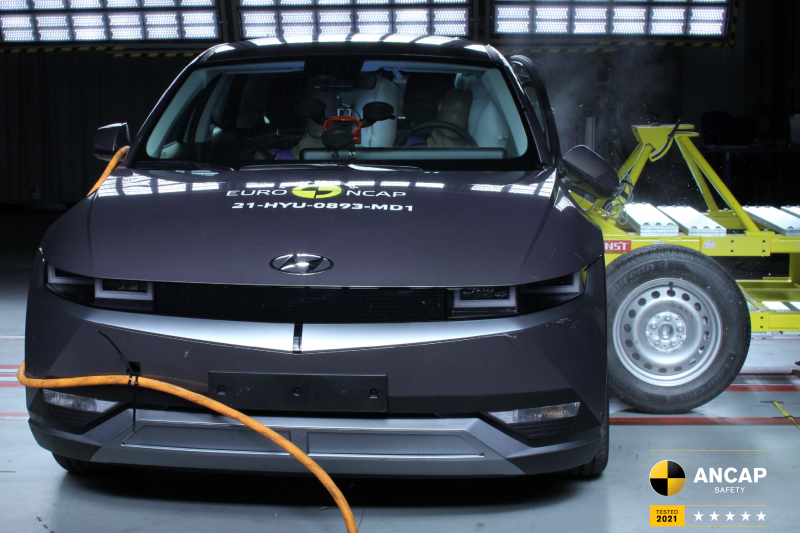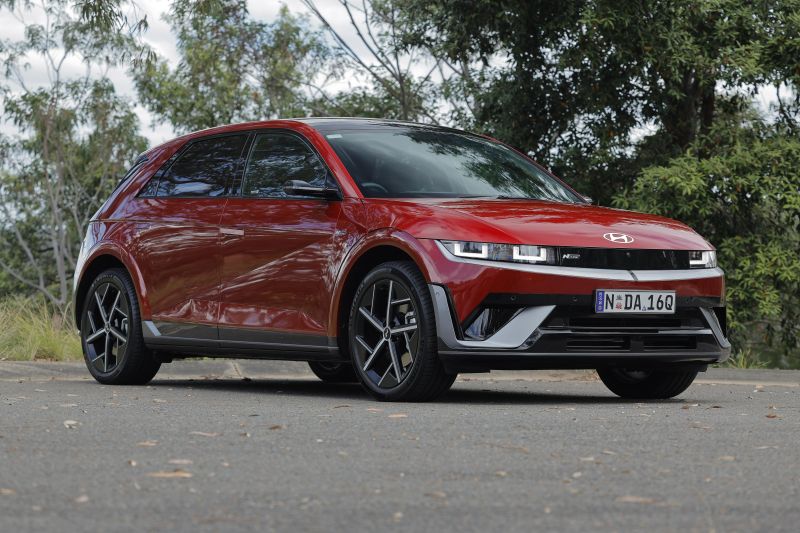Can you believe the Hyundai Ioniq 5 has already come for its ‘mid-life’ update?
It seems as though the quirky electric crossover SUV only went on sale a few months ago, but actually it was years ago.
Now, there’s more on offer from the South Korean brand’s first dedicated EV, including the optional N Line Package ($2500) you see in this review.
We’ll cover off what it’s like inside, what it’s like to drive, and some interesting and frustrating elements about this groundbreaking Korean EV, so read on for more!
How does the Hyundai IONIQ 5 compare?
View a detailed breakdown of the Hyundai IONIQ 5 against similarly sized vehicles.

Hyundai
IONIQ 5
How much does the Hyundai Ioniq 5 cost?
Bucking the trend – that’s what the Ioniq 5 has done since it was first launched in late 2021.
| Model | Price before on-road costs | Price change |
|---|---|---|
| 2025 Hyundai Ioniq 5 Standard Range RWD | $69,800 | +$2300 |
| 2025 Hyundai Ioniq 5 RWD Extended Range RWD | $75,800 | +$2300 |
| 2025 Hyundai Ioniq 5 Dynamiq Extended Range RWD | $80,800 | +$2300 |
| 2025 Hyundai Ioniq 5 Epiq Extended Range RWD | $84,300 | +$2300 |
| 2025 Hyundai Ioniq 5 Dynamiq Extended Range AWD | $85,300 | +$2300 |
| 2025 Hyundai Ioniq 5 Epiq Extended Range AWD | $88,800 | +$2300 |
But that’s not a good thing when it comes to bucking the trend set by many other EVs in terms of price reductions.
Indeed, the latest Ioniq 5 range is a significant chunk more expensive than the lineup it replaced, and it’s arguably even less competitive than it was before as a result.
Now, before you stop reading and dismiss those asking prices as way too steep, make sure you check out what you get for your money further down, because there are a heap of new standard inclusions.
To see how the Hyundai Ioniq 5 lines up against the competition, check out our comparison tool
What is the Hyundai Ioniq 5 like on the inside?
The cabin of the N Line-equipped variant tested in this review looks and feels a bit different than it did before, because it has scored a heap of new interior finishes, plus red trimming, and N-badged bits all over the place.
So if you’re not sold on the entry-level Ioniq 5, the N Line could be a goer. Personally, however, I like the beauty and simplicity of the regular Ioniq 5.
To me, the cabin finishes are a tad ‘try hard’, and you won’t fool anyone that you’ve got the ‘real N’ by getting them to jump into the passenger seat of this car.
Even so, there are several key changes to the cabin here, including that red trim highlight on the dashboard, the red stitching throughout, and the really nice ‘Eco-processed leather and Alcantara upholstery in black’. There are also N embroidered sections on the seats with a chequered flag motif – and the seats are just really comfortable.
In the Epiq flagship the front seats feature heating, cooling and memory functions, and there’s also the passive entry system whereby the driver can adjust the passenger seat via a set of satellite buttons, allowing a more graceful entrance for front- or rear-seat passengers getting in… or just to stop your kid from kicking the seat in front of them.
There is also the N-spec steering wheel, which – rather than being adorned with the four-dot logo as in other Hyundais (it’s Morse Code for ‘H’) – features a non-Morse N badge on the boxy centre hub of the tiller.
That’s an N Line-exclusive ‘semi-punched’ leather-wrapped steering wheel, by the way, with a red drive mode button and paddle shifters to adjust the regen braking.
Off the steering column on the right is the gear selector, which requires you to twist it in the direction you want to travel (forward for D, backward for R). That might seem intuitive, but it still catches me out.
There’s a pair of 12.3-inch displays – one for the driver, the other for media and car controls in the centre. The infotainment system is equipped with wireless Apple CarPlay and Android Auto, and it has satellite navigation for those who prefer a native mapping system.
Within the multimedia system is a host of simple menus to help get your head around the EV stuff you’ll want to know, like a charging timer and even the vehicle-to-load (V2L) limits.
The connected services setup for the Ioniq 5 even includes a weather app, and up near the mirror there’s an SOS button to call for help if you need it. Like similar systems, it automatically calls emergency services if you’re in a crash.
There’s now a touch panel for the climate control system including fan settings, but you do get a row of physical buttons to control seat heating, seat cooling and steering wheel heating. The latter is on the left, not the right, which is a weird little quirk of LHD-focussed manufacturing.
Storage space is excellent in the Ioniq 5. There’s a huge central bin beneath the armrest, plus console storage, and large cupholders alongside the wireless phone charging pad (with ‘status’ lights so you know your phone is actually charging).
Furthermore, there’s an additional storage box where the transmission tunnel would be, and bottle holders in the doors as well.
The sliding-drawer glovebox isn’t fitted to this one, but at least you don’t need to use a screen to open the glovebox as in some other silly EVs.
There’s a digital rear-view mirror that allows you to switch to a live camera feed if you have faces or luggage in the way. It’s cool tech, but it makes more sense in something with seven seats.
Our test car had the digital side mirrors as well – they’re a $3000 option, and it’s money poorly spent in my opinion. I understand they have a function and they’re a great talking point, but they don’t make it easier to see behind the car.
With the driver’s seat set in my position – I’m 182cm/6’0” tall – I had plenty of knee room to slide in behind, but toe room is a little bit tight because the battery pack is housed under the body of the car.
Headroom is good, even with the panoramic glass roof, and you can fit three people across the back if you need to, so long as they’re not massive.
Strangely, there’s also electric sliding adjustment for the back seat – which honestly seems a bit unnecessary.
The window seats have heating too, and those riding outboard will also get the best ventilation as the rear air vents are fitted in the B-pillars.
There are grab handles and good lighting in the rear of the cabin (handy for loading kids in or out at night), and there are pull-up sunshades on the back windows, too.
Topping off a family-friendly package are ISOFIX child seat anchors in the window seats, three top-tether points, and a flip-down armrest with cupholders, plus a pair of USB-C ports to keep devices juiced up.
The boot of the Ioniq 5 is also family-friendly with 527 litres of cargo capacity on offer, but under the boot floor there is no spare wheel – just some space for charging cables and a tyre repair kit. And there are no shopping bag hooks, which is a bit unsatisfying.
You can fold down the rear seats via a pair of switches in the boot area, too, and that liberates 1587L of cargo space, although you have to fold them back up manually from the back seat area.
| Dimensions | Hyundai Ioniq 5 |
|---|---|
| Length | 4655mm |
| Width | 1605mm |
| Height | 1890mm – excl. mirrors |
| Wheelbase | 3000mm |
| Cargo capacity | 527-1587 litres – boot 57 litres – 2WD front storage 24 litres – AWD front storage |
To see how the Hyundai Ioniq 5 lines up against the competition, check out our comparison tool
What’s under the bonnet?
There is also under-bonnet storage in the Ioniq 5, which differs between RWD (57 litres) and AWD (25 litres) variants.
| Specifications | Hyundai Ioniq 5 Epiq AWD |
|---|---|
| Drivetrain | Dual-motor electric |
| Battery | 84kWh lithium-ion |
| Power | 74kW + 165kW |
| Torque | 255Nm + 350Nm |
| Driven wheels | All-wheel drive |
| Weight – tare | 2180kg – Epiq 2190kg – Epiq N Line |
| 0-100km/h (claimed) | – |
| Energy consumption (claimed) | 18.21kWh/km – Epiq 18.11kWh/km – Epiq N Line |
| Driving range (claimed) | 500 kilometres – Epiq 495 kilometres – Epiq N Line |
| Max AC charge rate | 10.5kW |
| Max DC charge rate | 350kW |
To see how the Hyundai Ioniq 5 lines up against the competition, check out our comparison tool
How does the Hyundai Ioniq 5 drive?
Okay, before we get to the drive experience, we need to talk about the safety tech – because it’s annoying.
There is a speed sign recognition and warning system, like what many new models have, but it sounds a frustrating bing-bing alert if you go over what it thinks is the speed limit, which sometimes it gets very wrong – at one point it was reading 70km/h in a 110km/h zone!
Hyundai has introduced a shortcut via a long press of the mute button on the steering wheel to turn off the overspeed warning – meaning you can do an indicated 85 in an 80 zone and it won’t incessantly ding at you… but it still beeps every time it thinks the speed limit changes! What is wrong with Hyundai?!
You can turn it off completely if you want, by going through the media screen every time you set off, but this stuff makes good cars seem bad because it really gets on your nerves.
Thankfully, the steering wheel button for the lane keeping system is simple – just push and hold, and it turns that system off until you activate the adaptive cruise control… when it tries to turn it back on. And you have to fight with it to ensure it stays off if you don’t like it.
Look, these are personal taste things, and you might love the zealous driver assistance tech. But you’ll almost certainly be in the minority.
What makes all this such a shame is that the rest of the drive experience is actually very bloody good.
The Ioniq 5 has got really sweet handling – the steering is accurate and responsive, and you can push it through corners with plenty of gusto despite the fact it weighs 2190kg.
Even on 20-inch wheels the ride is supple, comfortable and well-judged. It never feels too soft or spongy, and nor is it too sharp or rough over bumpy sections of road. Yes, you can feel a sharp edge if you hit one, but it is surprisingly compliant over potholes and pockmarks.
It doesn’t have (or need) adaptive suspension, but the steering and powertrain response is greatly affected by the drive mode selected. It’s properly fast and has weighty steering feel in Sport, while in Eco is a bit duller and cruisier.
Indeed, the powertrain is excellent – it’s not ‘spit you out’ fast like a Tesla Model Y Performance, but there’s a nicely measured amount of grunt that’s easily manageable in mixed scenarios.
Plus, with the dual-motor all-wheel drive system, it feels surefooted and punchy when you push from a standing start or power hard and early out of a corner.
When it comes to stopping, there’s a lot to like too.
The Ioniq 5 has four different regen braking settings, including an i-Pedal mode that allows you to drive the car using only the throttle, no brake pedal needed. Otherwise, there are more sedate regenerative braking modes, which might suit you better.
It’s quiet at pace, never feels flummoxed by surface changes, and is just a really, really simple, enjoyable and user-friendly EV to drive… once you’ve turned off all the annoying safety tech!
To see how the Hyundai Ioniq 5 lines up against the competition, check out our comparison tool
What do you get?
The Ioniq 5 is available in three distinct trim levels in Australia.
Ioniq 5 highlights:
- Heat pump
- Battery preconditioning
- One-pedal drive mode
- Tyre pressure monitoring
- Automatic high-beam
- Automatic LED headlights
- 19-inch alloy wheels (new design)
- Tyre repair kit
- Acoustic laminated windscreen and side door glass
- Heated, power-folding exterior mirrors
- Rain-sensing wipers
- Proximity entry with push-button start
- Wool/leather upholstery
- Leather-wrapped steering wheel
- Cloth knit headliner
- LED interior lighting
- Alloy scuff plates
- Power windows with (NEW) auto up/down for all windows
- 10-way power driver’s seat
- 2-way manual reclining rear seats (fore/aft adjustment, 60:40 split/fold)
- 12.3-inch digital instrument cluster
- 12.3-inch touchscreen infotainment system
- Over-the-air updates (NEW)
- Wireless Apple CarPlay (NEW)
- Wireless Android Auto (NEW)
- Wireless phone charger
- 6-speaker sound system
- 4 x USB-C outlets (NEW)
- Dual-zone climate control
- Adjustable ambient lighting
- Electrochromatic rear-view mirror
- Remote Smart Parking Assist
- Virtual Engine Sound System (artificial propulsion sounds)
- Vehicle-to-load (V2L) functionality (outlet inside car)
Ioniq 5 Dynamiq adds:
- 20-inch alloy wheels (new design)
- 255/45 Michelin Pilot Sport EV tyres
- Rear privacy glass
- Power tailgate
- Leather upholstery
- Heated front seats
- 10-way power passenger seat
- Sliding centre console
- Alloy pedals
- Augmented reality head-up display
- 8-speaker Bose sound system
- Luggage net
Ioniq 5 Epiq adds:
- Intelligent Front Lighting System (NEW)
- Panoramic glass roof with power sunshade
- Premium ‘relaxation’ front seats
- Memory for all seats
- 2-way power rear seats
- Rear door sunshades
- Ventilated front seats
- Heated rear seats
- Heated steering wheel
Options
N Line Option Pack: $2500 (Dynamiq, Epiq)
- Unique front and rear bumpers
- Exclusive 20-inch alloy wheels
- Gloss black mirror caps
- Body-coloured cladding and wheel arches
- Unique hidden lighting signature
- Eco-processed leather and Alcantara upholstery in black,
- N Line-exclusive ‘semi-punched’ leather-wrapped steering wheel
- Metal pedals
- Red accents
Digital Mirror Pack: $3000 (Epiq)
To see how the Hyundai Ioniq 5 lines up against the competition, check out our comparison tool
Is the Hyundai Ioniq 5 safe?
The Hyundai Ioniq 5 has a five-star ANCAP safety rating based on testing conducted in October 2021.
| Category | Hyundai Ioniq 5 |
|---|---|
| Adult occupant protection | 88 per cent |
| Child occupant protection | 87 per cent |
| Vulnerable road user protection | 63 per cent |
| Safety assist | 89 per cent |
Standard safety equipment includes:
- 7 airbags incl. front-centre
- Autonomous emergency braking
- Vehicle detection
- Pedestrian detection
- Cyclist detection
- Evasive steering assist
- Lane change oncoming and side
- Reverse AEB
- Adaptive cruise control with stop/go
- Navigation-based cruise control (NEW)
- Blind-spot assist
- Blind Spot View Monitor
- Highway Driving Assist 2
- Adaptive cruise + lane centring (NEW)
- Intelligent Speed Limit Assist
- Lane Following Assist – lane centring
- Lane keep assist
- Rear occupant alert
- Rear cross-traffic assist
- Safe exit assist
- Surround-view camera
- Front and rear parking sensors
To see how the Hyundai Ioniq 5 lines up against the competition, check out our comparison tool
How much does the Hyundai Ioniq 5 cost to run?
Hyundai backs the Ioniq 5 with a five-year, unlimited-kilometre vehicle warranty, while the high-voltage battery is backed for eight years or 160,000km. Both of these aftersales provisions are on par with its rivals.
Service intervals are impressively lengthy, at 24 months/30,000km, meaning very long periods between visits to the dealer. And there is a capped price plan for the first three services, which costs $610 per visit.
Also, if you do service with Hyundai, there are roadside assistance top-ups each time, following the first 12 months of coverage for free.
Furthermore, the new Ioniq 5 comes with a five-year subscription to Bluelink connected services, which includes:
- Automatic Collision Notification (ACN)
- Emergency Call (SOS) function
- Connected Routing with live traffic updates
- Alert services including geo-fencing, valet, speed & time alerts
- Remote control of climate and vehicle functions
- Navigation Send-to-Car
- Voice recognition for POI lookup, vehicle controls
- Vehicle settings management
To see how the Hyundai Ioniq 5 lines up against the competition, check out our comparison tool
CarExpert’s Take on the Hyundai Ioniq 5
I love the Ioniq 5 for being what it is: different. It’s cuts a great shape, offers great space and practicality, and the drive experience is still sweet in most ways…
Some of those annoying driver assistance technologies really got to me during my time in this car though, and the price increases are a hard pill to swallow.
Interested in buying a Hyundai Ioniq 5? Get in touch with one of CarExpert’s trusted dealers here
Click the images for the full gallery
MORE: Everything Hyundai Ioniq 5



